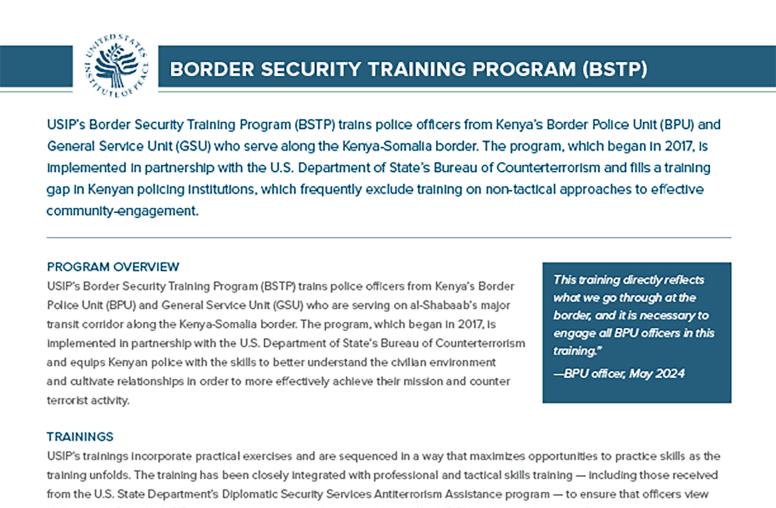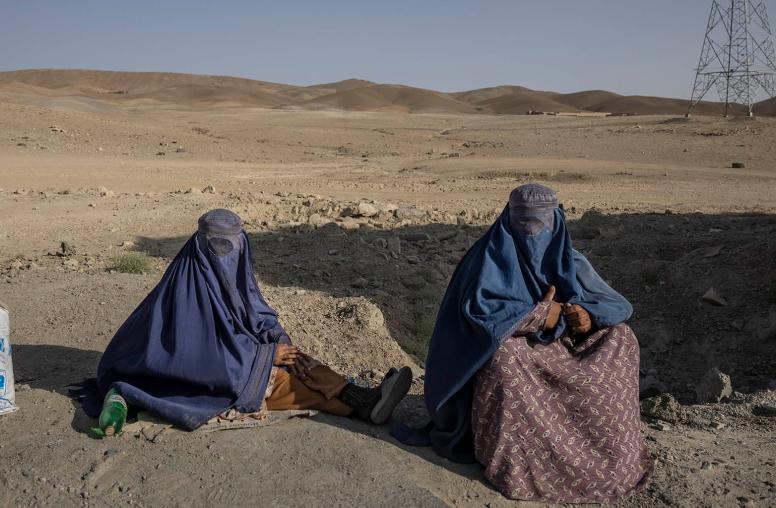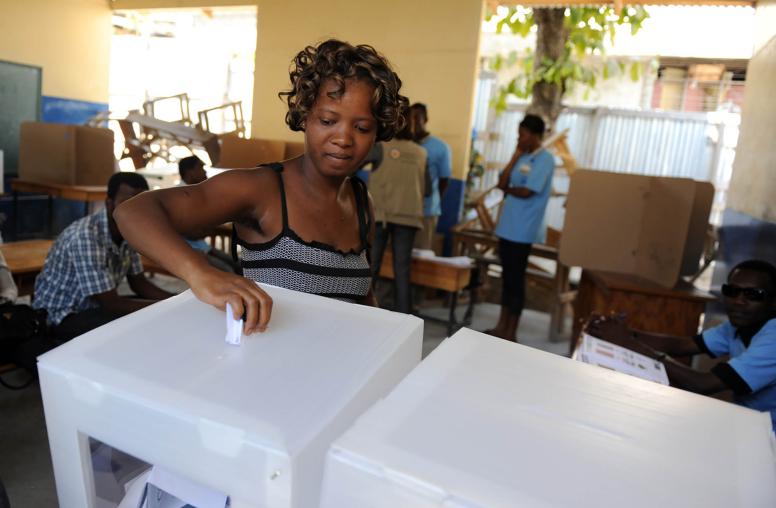Five Gains and Gaps in the Campaign to End Conflict-Related Sexual Violence
Sexual violence is not an inevitable consequence of war — but the international community must do more to prevent it.
The wars of the 1990s — particularly in the former Yugoslavia, Rwanda, Sierra Leone and the Democratic Republic of the Congo (DRC) — saw the devastating use of sexual violence not only by individual subordinate soldiers, but as deliberate tactics of war by state and non-state armed actors. In response, a wave of strong advocacy from women’s civil society organizations called for an end to these acts of violence, and they demanded a say in peace and security negotiations. Their vision was eventually incorporated into U.N. Security Council Resolution (UNSCR) 1325 (2000) and what is now known as the Women, Peace and Security (WPS) agenda.

The protection of women from conflict-related sexual violence (CRSV) has become a key pillar of the WPS agenda. The United States brought specific attention to the issue in the U.N. Security Council in 2008. And a year later, at the behest of the Security Council, the U.N. secretary-general appointed a special representative tasked with addressing CRSV — marking the start of a new push in the international effort to end sexual violence as a tactic of war.
Numerous initiatives across the globe have taken up the mantle of preventing CRSV in the years since, and the question of how to assess their progress has emerged alongside them. A 2013 USIP-hosted symposium was an early response to this question, and sought to evaluate WPS policies and programming and strengthen the community of knowledge and practice by breaking down the siloes between various disciplinary and state boundaries.
Earlier this month, USIP and its partners reconvened many of the same experts from the 2013 symposium, as well as new stakeholders, to take renewed stock of the gains and gaps in the international campaign to prevent and eliminate CRSV. The three-day Missing Peace Symposium identified five major signs of progress — and five major shortfalls in the mobilization against CRSV.
Ending Conflict-Related Sexual Violence: The Gains
CRSV is gaining momentum as a part of the broader peace and security policy agenda. A number of impressive accomplishments all show increased political attention to the issue of CRSV, including five separate U.N. Security Council resolutions, the appointment of a U.N. special representative, several G-7 initiatives, the U.K.’s Preventing Sexual Violence in Conflict Initiative, annual reports from the U.N. secretary-general, yearly open debates at the U.N., and many speeches by national policymakers. There is now broad rhetorical consensus within the policymaking communities that CRSV must be stopped and — importantly — that it can be prevented.
A better global understanding of CRSV. There is increased global recognition that CRSV is a multidimensional and complex problem. Any solutions for CRSV must therefore simultaneously engage a large array of stakeholders — from survivors and victims to practitioners, academics and policymakers. In addition, policymakers have increasingly recognized that CRSV is not just about rape, but also about other forms of sexual assault and gender-based violence, including sexual slavery, forced marriages and sexual torture. Lastly, policymakers have recognized that CRSV affects not only women, but also men and boys, people with non-heterosexual sexual orientations and gender minorities. The academic and policy communities have recognized that any analysis looking at vulnerabilities to CRSV must be intersectional and take into account economic positions and ethnic backgrounds.
The growth of strong normative frameworks. Although wartime sexual violence has been outlawed since 1907, it was not until the 1990s, under the aegis of the International Criminal Tribunal for the former Yugoslavia, that explicit charges were brought forward for wartime sexual violence. Rape as a war crime was further codified in the Rome Statute of the International Criminal Court (ICC) in 1998. In March 2016, the ICC pronounced its first conviction for wartime sexual violence crimes. Since that time, the court has expanded its jurisprudence and developed new policies, including one on gender-based crimes and crimes against children, with the finalized versions set to be released in December 2023.
Of the 10 U.N. Security Council resolutions on WPS, five have explicitly focused on CRSV. At the global level, governmental and non-governmental organizations have developed international protocols for the documentation and investigation of sexual violence in conflict, as well as codes that ensure the protection of the rights of survivors. The work of the U.N. special representative for CRSV has been critical in expanding and deepening our understanding and establishing standards — including guidance on data collection, remedial measures, reparations and prevention.
At the national level, some countries, such as Germany, have expanded existing war crime definitions under the principle of universal jurisdiction to include sexual violence. This has allowed German courts to convict members of ISIS for crimes committed in Iraq against Yazidis, including crimes of sexual violence. In addition, many transitional justice efforts increasingly incorporate sexual violence and gender-based crimes in their mandates. All this provides a strong legal basis for prosecution, as well as preventive and remedial work.
The expansion of CRSV scholarship. Two decades ago, the study of CRSV was a marginal topic in academic departments. In the 1990s, only some 140 academic articles were published on conflict-related sexual violence. Today, the number of academic articles runs in the thousands. The first meeting of USIP’s Missing Peace Scholar Network in 2012 brought together two dozen young scholars. A decade later, that number has increased four-fold.
And not only has the quantity of research expanded, so has the quality. One of the most important findings in the past decade has been that sexual violence is not an inevitable consequence of war. Researchers have found quite a bit of variation in the prevalence of CRSV among armed groups — even within the same conflicts. Rather than CRSV being unavoidable, researchers have highlighted the role of ideology, forced recruitment and the type of resources armed groups rely on as key predictors of the prevalence of sexual violence. Lastly, researchers have shown strong correlations between gender inequality, patriarchal gender relations and the prevalence of wartime sexual violence.
More attention to survivor-centered approaches. In 2019, the U.N. Security Council recognized the importance of survivor-centered approaches, and U.N. Special Representative Pramila Patten has made a survivor-centered approach to CRSV her top priority. Policymakers and practitioners increasingly recognize that survivors have agency and that they should not be treated solely as victims, as if they are too vulnerable to be heard. Survivor organizations, such as the Global Network of Victims and Survivors and the Survivor Speak OUT network, have grown in strength over the past 10 years and are vocal about being involved and engaged on policies having to do with CRSV, from prevention to legal measures to reparations.
Gaps in the Conflict-Related Sexual Violence Agenda
CRSV is on the agenda, but it is not a policy priority. Even though CRSV has received increased attention from the policy community, sexual violence during and after war continues unabated in many conflicts around the globe, including in Ukraine, Myanmar, Sudan and the DRC.
In addition, the political discourse around sexual violence in conflict and post-conflict settings is prone to intellectual shortcuts and has a tendency to perpetuate widely held erroneous beliefs. The framing of CRSV in the U.N. Security Council as a protection issue has created a tendency to ignore the gendered and structural causes of CRSV, including the continuum of sexual and gender-based violence before, during and after conflict.
Lastly, and most importantly, the global political climate has greatly deteriorated in the past decade. Political backlash against gender equality initiatives, including the WPS agenda and efforts to stop CRSV, have become more prominent and risk derailing gender equality agendas, as well as efforts to ban CRSV, at national and global levels.
A lack of implementation and funding. Despite the increased number of normative frameworks, their implementation continues to lag, and impunity remains the rule. There is also a lack of expertise, professional staffing and training within governmental organizations. Lastly, the resources allocated to the prevention and elimination of CRSV at both national and international levels are abysmal. As of December 2022, the U.N. Conflict-Related Sexual Violence Multi-Partner Trust Fund had a mere $20 million at its disposal. Meanwhile, U.N. Action — a network of 24 U.N. entities to end CRSV — is facing severe financial shortfalls year upon year.
There is insufficient attention paid to the full range of causes and perpetrators of CRSV. One of the main findings of research studies over the past decade has been that most perpetrators of CRSV are state actors. Yet, at the policy level, non-state actors continue to be the primary focus of attention. In academia, not enough research is undertaken to examine under which conditions states resort to sexual and gender-based violence. In addition, research that examines the structural and systemic causes of CRSV — including patriarchal systems and notions of masculinity that value strength and violence and see sexuality as acts of procreation, control and dominance — are insufficiently informing policymaking.
The question of how to approach children born of war. In recent years, a growing number of researchers have called attention to the situation of children born as a result of CRSV. As Norwegian scholar Inger Skjelsbaek observes, CRSV is the only war crime that results in a human being born. These children often have to deal with multiple traumas, including abandonment, stigma and statelessness — thus, many of these children face very specific psycho-social problems that are not being addressed by policymakers.
CRSV is hampered by policy siloes. CRSV is a problem with social, economic, political, military and legal aspects. Ending wartime sexual violence therefore requires multi-pronged approaches across different sectors. Unfortunately, most national and international institutions are organized along strict functional, regional and funding lines. These types of structures do not reward cooperation and horizontal collaborative efforts. In addition, CRSV policies are insufficiently integrated and connected to other policy agendas such as the U.N.’s Sustainable Development Goals or the impacts of climatic change, including migration movements and the trafficking of persons. The lack of integration creates blind spots both in terms of identifying this type of criminal behavior and in terms of policy responses, including remedial and preventive measures.
The Way Forward on Conflict-Related Sexual Violence
Eliminating conflict-related sexual violence requires multi-pronged approaches across national boundaries, across disciplines and across professional fields. The Missing Peace Initiative seeks to bring together different stakeholders — including practitioners, humanitarian actors, military officials, academics, policymakers and survivors — to find a common language and approaches to eliminate CRSV and help mitigate its effects.
“Together Taking Action” is the clarion call of the Missing Peace Initiative. But above all, the initiative is carried by the actions of civil society organizations. They are and have always been critical in moving the WPS and CRSV agendas forward. It is thanks to their efforts that CRSV has become part of the international peace and security lexicon, and their actions will continue to be needed to hold governments accountable, to stop the impunity of perpetrators, and more generally, to make sure that the political backlash against gender equality initiatives is halted.
Dr. Chantal de Jonge Oudraat is a member of the board of directors at Women in International Security and a global fellow at the Wilson Center.
Kuehnast and Oudraat are two of the founding partners of the Missing Peace Initiative.



